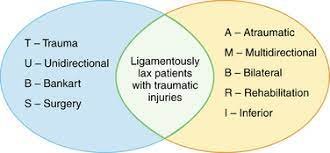Sarah’s (UN)STABLE SHOULDER STORY
We’ll get to Sarah’s story in a second, let’s first orient ourselves to the shoulder, chronic vs traumatic instability, the role of the rotator cuff and common symptoms.
Shoulder Breakdown
Shoulders are incredibly mobile, in fact, the most mobile joint. Pairing that with it being the most “complex” joint we have, can make dealing with shoulder pain difficult in a sense. Let’s break that down, the shoulder is a “ball and socket” joint, consisting of 3 bones (scapula, humerus, and clavicle (collarbone), a dozen muscles, and more than a few ligaments that provide forms of support.
Traumatic vs Atraumatic/Chronic Stability
There are two major ways we can develop this “instability”. There are traumatic incidents such as shoulder dislocation or subluxation during activity. There is also chronic instability that may stem from a previous traumatic injury, past history, genetic differences, or overall “wear and tear”. We will be focusing on chronic instability today.
Dynamic vs Static Stability
Dynamic: muscles and tendons of the shoulder, including the rotator cuff activate in patterns based on movement demands to help secure the complex ball and socket position.
Static: ligaments and capsular connective tissue help guide the ball and socket’s position.
During chronic instabilities, the static stability is often lessened which causes the dynamic stabilizers to do MORE work. This can cause fatigue of the dynamic stabilizers over time. If they are not “strong” enough or have the correct order of operations to perform the desired movement patterns, this can present as instability symptoms.
Main symptoms:
Shoulder feels “loose” or “unstable”
Feeling of clicking or popping
Shoulder “gives out”
Apprehension or nervousness in shoulder when performing abduction and external rotation positions (throwing a ball, swinging at a volleyball, catching a snatch, etc)
Rehab of the Unstable Shoulder
This can look very different based on your goals, activities, and symptoms. However, Sarah, to explain her rehab process.
Sarah’s Story
Sarah is 32 years old and has a 3 year old son. Sarah is an avid crossfitter and former collegiate swimmer. She attends noon class 3 to 4 times per week at her local Crossfit box. She mentioned having some shoulder pain while swimming in college, but had mostly been managing it well.
She came in a few months ago with shoulder pain that she couldn’t necessarily pinpoint the exact location of, mentioning “it’s kind of all around my shoulder and not consistent”.
A few months prior she started to notice she wasn’t making much progress on her snatch weight and wasn’t able to catch the weight overhead. She didn’t have much pain at the time, but mentioned it as part of her history.
Three weeks before her appointment with us, she did a benchmark workout in Crossift called Fran. If you’re not familiar with Fran, it’s a gnarly workout and very shoulder taxing. She felt her right shoulder getting more and more fatigued throughout the workout and couldn’t control her repetitive pull ups as well as she normally could.
That night, she had difficulty sleeping in her typical right sided position because her shoulder felt so painful and loose.
Sarah skipped the gym for a few days, thinking rest, ice, and Ibuprofen would help. She went to the gym a week later, and actually felt worse. She couldn’t even hang from the pull up bar or press a “light “dumbbell overhead.
That’s when Sarah sought help.
With Sarah’s history of being a swimmer, past shoulder pain, review of her more recent history and thorough evaluation; Sarah was started on a rehab program that consisted of the following:
Put the Fire Out: Calming down angry muscles of the rotator cuff and deltoid with use of dry needling and myofascial decompression. This started the process of putting the fire out of her symptoms to allow her to sleep better and do some more progressive exercises
Strength: Progressively overloading her shoulder into multiple positions and ranges of motion. This included scapular, rotator cuff, and deltoid strengthening. We matched the intensity of the exercise to her irritability. This is key in your rehab progression, doing exercises that aren’t intense enough, will eventually not be enough to progress the shoulder. Doing exercises that are too intense for your pain, can also hinder progression.
Use the gym, don’t avoid it: Modifying gym activities for the current time period was a huge game changer for Sarah. We broke down the next week of her workouts at the gym and decided together what she could do and what some things to modify were. Sarah enjoyed exercising with her community, so we wanted her to use the gym, not avoid the gym.
This rehab program took just 10 weeks to fully complete. As she progressed further into her program, she was able to do more and more in the gym and the rehab program looked more and more like a workout for her.
Shoulder stability can be a tricky pain to deal with. But with solid, fundamental rehab programs you too can achieve pain relief like Sarah. If this sounds like you, we’d love to help you out, too!


